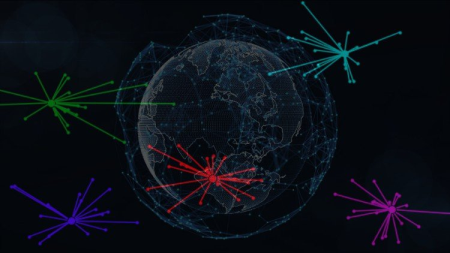
MP4 | Video: h264, 1280x720 | Audio: AAC, 44.1 KHz, 2 Ch
Genre: eLearning | Language: English + .srt | Duration: 33 lectures (5h 17m) | Size: 1.8 GB
Students should have some experience with Python.
Cluster Analysis: core concepts, working, evaluation of KMeans, Meanshift, DBSCAN, OPTICS, Hierarchical clustering
Understand the KMeans Algorithm and implement it from scratch
Learn about various cluster evaluation metrics and techniques
Learn how to evaluate KMeans algorithm and choose its parameter
Learn about the limitations of original KMeans algorithm and learn variations of KMeans that solve these limitations
Understand the DBSCAN algorithm and implement it from scratch
Learn about evaluation, tuning of parameters and application of DBSCAN
Learn about the OPTICS algorithm and implement it from scratch
Learn about the cluster ordering and cluster extraction in OPTICS algorithm
Learn about evaluation, parameter tuning and application of OPTICS algorithm
Learn about the Meanshift algorithm and implement it from scratch
Learn about evaluation, parameter tuning and application of Meanshift algorithm
Learn about Hierarchical Agglomerative clustering
Learn about the single linkage, complete linkage, average linkage and Ward linkage in Hierarchical Clustering
Learn about the performance and limitations of each Linkage Criteria
Learn about applying all the clustering algorithms on flat and non-flat datasets
Learn how to do image sntation using all clustering algorithms
Some experience with data visualizations
Some experience with Numpy
Some background in computer science.
Clustering is the activity of splitting the data into partitions that give an insight about the unlabelled data. It gives a structure to the data by grouping similar data points
We see these clustering algorithms almost everywhere in our everyday life. Cluster Analysis has and always will be a staple for all Machine Learning. Clustering has its applications in many Machine Learning tasks: label generation, label validation, dimensionality reduction, semi supervised learning, Reinforcement learning, computer vision, natural language processing.
For a data scientist, cluster analysis is one of the first tools in their arsenal during exploratory analysis, that they use to identify natural partitions in the data.
In this course, you will learn some of the most important algorithms used for Cluster Analysis
Each dataset and feature space is unique. You cannot use a one-size-fits-all method for recognizing patterns in the data. Each algorithm has its own purpose.
By studying the core concepts and working in detail and writing the code for each algorithm from scratch, will empower you, to identify the correct algorithm to use for each scenario.
Some algorithms are fast and are a good starting point to quickly identify the pattern of the data
And some algorithms are slow but more precise, and allow you to capture the pattern very accurately.
You will get to understand each algorithm in detail, which will give you the intuition for tuning their parameters and maximizing their utility
In this course, for cluster analysis you will learn five clustering algorithms:
You will learn about KMeans and Meanshift. These are two centroid based algorithms, which means their definition of a cluster is based around the center of the cluster.
Next you will study DBSCAN and OPTICS. These are density based algorithms, in which they find high density zones in the data and for such continuous density zones, they identify them as clusters.
Another type of algorithm that you will learn is Agglomerative Clustering, a hierarchical style of clustering algorithm, which gives us a hierarchy of clusters.
For each algorithm, you will understand the core working of the algorithm. What parameters they use. How to choose and tune these parameters. How to evaluate the results for each algorithm. To consolidate your understanding, you will also apply all these learnings on multiple datasets for each algorithm. You can later compare all the algorithms and their performance.
This course can be your only reference that you need, for learning about various clustering algorithms.
The correct approach to this course is going in the given order the first .
Follow along the introductory lecture. It is highly recommended that during the coding lessons, you must code along. I have provided detailed jupyter notebooks along the course. You can keep them for reference. But it is highly recommended that you code along.
You can pause the lesson. Write the code needed and at the same think about the working flow.
I assure you, there onwards, this course can be your go-to reference to answer all questions about these algorithms. You will have a life of access to this course, and thus you can keep coming back to quickly brush up on these algorithms
People interested in Machine Learning
People who want to study unsupervised learning
People who want to learn pattern recognition in data
DOWNLOAD
uploadgig
https://uploadgig.com/file/download/b03f0598Ad6e4ab6/Xkt7n2LY__Unsupervis.part1.rar
https://uploadgig.com/file/download/9967A4c45C1efcd6/Xkt7n2LY__Unsupervis.part2.rar
rapidgator
https://rapidgator.net/file/7347b822f81dacdf11ec5061b38edd6b/Xkt7n2LY__Unsupervis.part1.rar
https://rapidgator.net/file/dd9d6073c0cb109c36fc121cd0480f52/Xkt7n2LY__Unsupervis.part2.rar
nitroflare
http://nitroflare.com/view/7C960862C3D677F/Xkt7n2LY__Unsupervis.part1.rar
http://nitroflare.com/view/604811EC07C4C89/Xkt7n2LY__Unsupervis.part2.rar

